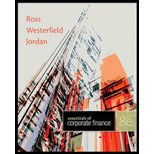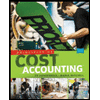
Essentials of Corporate Finance
8th Edition
ISBN: 9780078034756
Author: Stephen A. Ross, Randolph W. Westerfield, Bradford D. Jordan
Publisher: MCGRAW-HILL HIGHER EDUCATION
expand_more
expand_more
format_list_bulleted
Question
Chapter 17.1, Problem 17.1DCQ
Summary Introduction
To discuss: The advantage of eliminating or reducing float.
Introduction:
Cash management refers to the process of handling and using cash in the business. It is necessary because the businesses are motivated to hold cash for speculation, precaution, and for carrying out business-related transactions.
Float refers to the difference between the cash value mentioned in the books and the cash value mentioned in the bank passbook.
Expert Solution & Answer
Want to see the full answer?
Check out a sample textbook solution
Students have asked these similar questions
When the price of a bond is above the face value, the bond is said to be*
Trading at par
Trading at a premium
Trading at a discount
Trading below par
7. What is a par value of a bond?*
The amount borrowed by the issuer of the bond and returned to the investors when the bond matures
The overall return earned by the bond investor when the bond matures
The difference between the amount borrowed by the issuer of bond and the amount returned to investors at maturity
The size of the coupon investors receive on an annual basis
What is an annuity?*
An investment that has no definite end and a stream of cash payments that continues forever
A stream of cash flows that start one year from today and continue while growing by a constant growth rate
A series of equal payments at equal time periods and guaranteed for a fixed number of years
A series of unequal payments at equal time periods which are guaranteed for a fixed number of years
Chapter 17 Solutions
Essentials of Corporate Finance
Ch. 17.1 - Prob. 17.1ACQCh. 17.1 - Prob. 17.1BCQCh. 17.1 - Prob. 17.1CCQCh. 17.1 - Prob. 17.1DCQCh. 17.2 - Prob. 17.2ACQCh. 17.2 - Prob. 17.2BCQCh. 17.2 - Prob. 17.2CCQCh. 17.2 - Prob. 17.2DCQCh. 17.3 - Prob. 17.3ACQCh. 17.3 - Prob. 17.3BCQ
Ch. 17.3 - Prob. 17.3CCQCh. 17.4 - Prob. 17.4ACQCh. 17.4 - Prob. 17.4BCQCh. 17.4 - Prob. 17.4CCQCh. 17 - Prob. 1CTCRCh. 17 - Cash Management. What options are available to a...Ch. 17 - LO1 17.3Agency Issues. Are stockholders and...Ch. 17 - Prob. 4CTCRCh. 17 - Short-Term Investments. Why is a preferred stock...Ch. 17 - Prob. 6CTCRCh. 17 - Float. Suppose a firm has a book balance of 2...Ch. 17 - Prob. 8CTCRCh. 17 - Agency Issues. It is sometimes argued that excess...Ch. 17 - Use of Excess Cash. One option a firm usually has...Ch. 17 - Use of Excess Cash. Another option usually...Ch. 17 - Float. An unfortunately common practice goes like...Ch. 17 - Credit Instruments. Describe each of the...Ch. 17 - Trade Credit Forms. In what form is trade credit...Ch. 17 - Receivables Costs. What are the costs associated...Ch. 17 - Prob. 16CTCRCh. 17 - Credit Period Length. What are some of the factors...Ch. 17 - Credit Period Length. In each of the following...Ch. 17 - Prob. 19CTCRCh. 17 - Prob. 20CTCRCh. 17 - Prob. 1QPCh. 17 - Prob. 2QPCh. 17 - Prob. 3QPCh. 17 - Prob. 4QPCh. 17 - Prob. 5QPCh. 17 - Prob. 6QPCh. 17 - Prob. 7QPCh. 17 - Prob. 8QPCh. 17 - Prob. 9QPCh. 17 - Prob. 10QPCh. 17 - Prob. 11QPCh. 17 - Prob. 12QPCh. 17 - Prob. 13QPCh. 17 - Prob. 14QPCh. 17 - Prob. 15QPCh. 17 - Safety Stocks and Order Points. Sach, Inc.,...
Knowledge Booster
Similar questions
- If you were able to earn interest at 3% and you started with $100, how much would you have after 3 years?* $91.51 $109.27 $291.26 $103.00arrow_forwardNo AI 2. The formula for calculating future value (FV) is* FV = PV/(1+r)^n FV = PV/(1+r)*n FV = PV x (1+r)^n FV = PV x (1+r)*narrow_forwardDividend??? solnarrow_forward
- Hello tutor need barrow_forwardMoose Enterprises finds it is necessary to determine its marginal cost of capital. Moose’s current capital structure calls for 50 percent debt, 30 percent preferred stock, and 20 percent common equity. Initially, common equity will be in the form of retained earnings (Ke) and then new common stock (Kn). The costs of the various sources of financing are as follows: debt, 9.6 percent; preferred stock, 9 percent; retained earnings, 10 percent; and new common stock, 11.2 percent. a. What is the initial weighted average cost of capital? (Include debt, preferred stock, and common equity in the form of retained earnings, Ke.) b. If the firm has $18 million in retained earnings, at what size capital structure will the firm run out of retained earnings? c. What will the marginal cost of capital be immediately after that point? (Equity will remain at 20 percent of the capital structure, but will all be in the form of new common stock, Kn.) d. The 9.6 percent cost of debt referred to earlier…arrow_forward7. Berkeley Farms wants to determine the minimum cost of capital point for the firm. Assume it is considering the following financial plans: Cost (aftertax) Weights Plan A Debt .................................. 4.0% 30% Preferred stock .................. 8.0 15 Common equity ................. 12.0 55 Plan B Debt .................................. 4.5% 40% Preferred stock .................. 8.5 15 Common equity ................. 13.0 45 Plan C Debt .................................. 5.0% 45% Preferred stock .................. 18.7 15 Common equity ................. 12.8 40 Plan D Debt .................................. 12.0% 50% Preferred stock .................. 19.2 15 Common equity ................. 14.5 35 a. Which of the four plans has the lowest weighted average cost of capital? Use the Kd (cost of debt) = Y(1 - T), Kp (Cost of preferred stock) = Dp/Pp - F, Ke = D1/P0 + g formulas or I will not understand.arrow_forward
arrow_back_ios
SEE MORE QUESTIONS
arrow_forward_ios
Recommended textbooks for you
 Managerial AccountingAccountingISBN:9781337912020Author:Carl Warren, Ph.d. Cma William B. TaylerPublisher:South-Western College PubPrinciples of Accounting Volume 2AccountingISBN:9781947172609Author:OpenStaxPublisher:OpenStax College
Managerial AccountingAccountingISBN:9781337912020Author:Carl Warren, Ph.d. Cma William B. TaylerPublisher:South-Western College PubPrinciples of Accounting Volume 2AccountingISBN:9781947172609Author:OpenStaxPublisher:OpenStax College Cornerstones of Cost Management (Cornerstones Ser...AccountingISBN:9781305970663Author:Don R. Hansen, Maryanne M. MowenPublisher:Cengage Learning
Cornerstones of Cost Management (Cornerstones Ser...AccountingISBN:9781305970663Author:Don R. Hansen, Maryanne M. MowenPublisher:Cengage Learning Principles of Cost AccountingAccountingISBN:9781305087408Author:Edward J. Vanderbeck, Maria R. MitchellPublisher:Cengage Learning
Principles of Cost AccountingAccountingISBN:9781305087408Author:Edward J. Vanderbeck, Maria R. MitchellPublisher:Cengage Learning

Managerial Accounting
Accounting
ISBN:9781337912020
Author:Carl Warren, Ph.d. Cma William B. Tayler
Publisher:South-Western College Pub

Principles of Accounting Volume 2
Accounting
ISBN:9781947172609
Author:OpenStax
Publisher:OpenStax College


Cornerstones of Cost Management (Cornerstones Ser...
Accounting
ISBN:9781305970663
Author:Don R. Hansen, Maryanne M. Mowen
Publisher:Cengage Learning

Principles of Cost Accounting
Accounting
ISBN:9781305087408
Author:Edward J. Vanderbeck, Maria R. Mitchell
Publisher:Cengage Learning